#Krishna consciousness
Text
Something I find fascinating about the Critical Edition of the Mahābhārata is that the characters sporadically move from addressing Kṛṣṇa as an embodied mortal (as their friend, cousin, son-in-law etc) to addressing him as the Godhead; as Viṣṇu, as the Supreme Being, and as Īśvara. The succession of change between the modes of address can sometimes even happen on the same page, at a distance of a few lines. The veil is lifted, and the characters see through Kṛṣṇa’s illusion, and, through that, they become immersed in the nature of Reality; the veil promptly drops back, and God is lost. An argument for this could be that the divine modes of address are interpolations, a theory being that Kṛṣṇa became identified with Viṣṇu only in later renditions of the Mahābhārata. While this could be true at the level of historical analysis of the epic, for me, there is a subtler teaching encased here: how all of us, without exception, glimpse into the nature of Reality as we move through life, yet we perpetually proceed to return to becoming engrossed in the superimpositions we project upon Reality; and the dance continues. From Truth to dream, from dream to Truth. It is quite endearing, really. What committed and imaginative dreamers we are!
Adyashanti once talked about how one inadvertently glimpses truth; it is, after all, inescapable as it is our nature; the trick is not forgetting / losing the glimpse.
Gorgeous artwork of Kṛṣṇa: Awedict.




#mahabharata#krishna#mahabharat#mahabharatam#gopala#govinda#adyashanti#nonduality#non dualism#non duality#avatara#hare krishna#krishna consciousness#hinduism#hindu art#awedict#bhagavad gita#vishnu#ishvara#bhakti#hindu mythology#itihasa#sanskrit#hindu#gopal
121 notes
·
View notes
Text
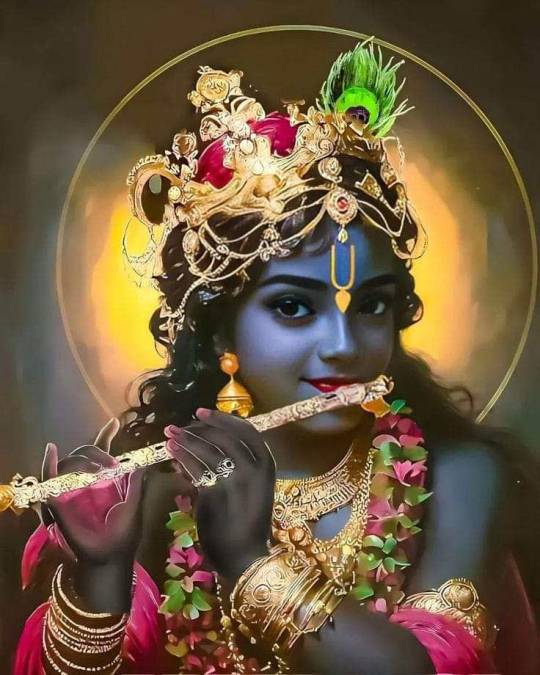
ODE TO MURALIDHAR (KRSNA)
O Divine Flute-Player:
How You attract souls towards You
With Your alluring melodies
Is beyond comprehension.
You melt all in the crucible of Divine Beauty
And Love Profound!
Sweet Muralidhar,
Let all your bhaktas taste
The sweetness of Your Sacred nectar,
Savored through the remembrance of Your Holy Name!
Love Divine, Sweet Love!
Come, play the Tune of Bliss
In the flute of our Spine!
Our Souls shall then sing,
Your ambrosial melodies.
Let the Wind of Your Divine Breath
Ascend and Descend through us!
Then shall the song of Divine Praise resound
Through us, Your intoxicated lovers!
#hinduism#poems and quotes#poetry#sanatana dharma#spiritual#kriya#kriya yoga#krsna#hare krishna#hare krsna#krishna#vishnu#bhagavad gita#bhakti#hindu#iskcon#krishna consciousness
21 notes
·
View notes
Text

on the banks of Gaṅgā
you held me all night, my Lord
unseen to the eye,
your grace, a lover's touch, wrapped my skin
unheard to the ears,
your name, my japa, vibrated through my braincells
Monsoon One, do you long for me as fully as i long for you?
do you call on me as ardently as i call on you?
you do, don't you, my Lord?
i am not alone in this quest
for every step i take towards you,
you take two towards me
for every tear i spill in yearning for you,
you ignite vīrya in my skin tissue
for every test of yours that i fail,
you yank me freer of delusion
i see it now, Hari.
you have been pulling me
by my hair and hands to you.
it was all you. it was always all you.
if i run to you as fast as my legs can take me,
will you meet me halfway?
you will, won't you, my Lord?
🦚 Happy Kṛṣṇa Janmāṣṭamī! 🙏 poem from my upcoming collection "the Monsoon One and the pilgrim". 💛
photo: Rishikesh, October 2022.
#bhakti#bhakti poetry#krishna#govinda#gopala#haribol#hindu#hinduism#vaishnava#krishna janmashtami#krishna janmastami#hare krishna#ganga#ganges#rishikesh#india#bharat#sari#devotional poetry#krishna consciousness
40 notes
·
View notes
Text
I got manmohaned.
48 notes
·
View notes
Text
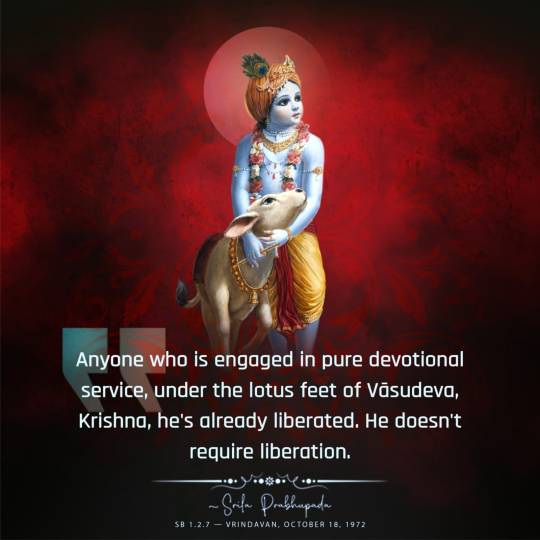
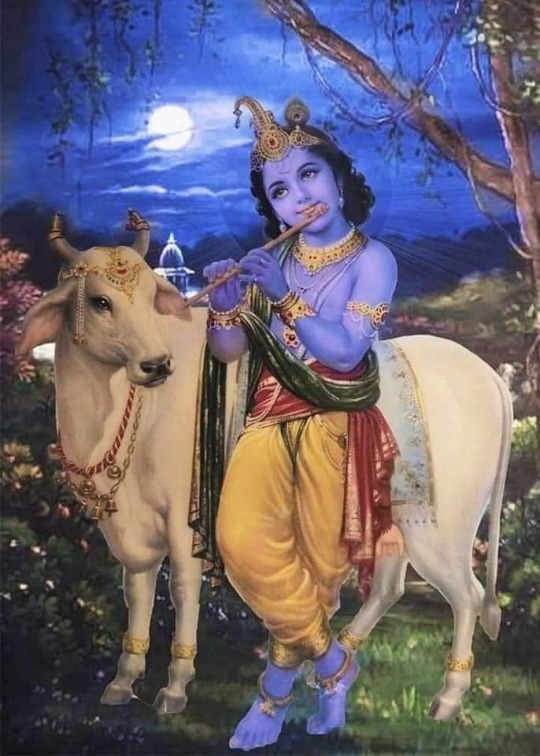
youtube
#youtube#iskcon#hare krishna#krishna#bhakti#srila prabhupada#vedic#music#bhagavad gita#Darshan#Bhajan#Kirtan#Maha Mantra#Krishna Consciousness
11 notes
·
View notes
Text
Cro-Mags is one of the most influential New York hardcore punk bands and was the first to combine hardcore punk with heavy metal. Dave Grohl (Foo Fighters, Nirvana) credited the band with having had a primal influence on their development. Before joining Nirvana, Grohl was in the punk band Scream and opened for Cro-Mags at CBGB.
Krishnacore was ‘‘the first time that hardcore and straight edge punks had to deal specifically with religion on an intellectual and personal level’’(Stewart, 2017,p.52).
© Grunge Included | @37fotosb | Linktree
#cro mags#youth of today#krishna consciousness#punk#nirvana#krishnacore#rock music#alternative#grunge#hardcore punk#new york#108#hardcore music#post hardcore#animal rights#vegan#protest music#substack#music#History#american culture#america
2 notes
·
View notes
Text
PRABHUPADA IS THE MOST COMPASSIONATE SOUL IN THE ENTIRE WORLD
This is an offering in the honour of Prabhupāda on His Disappearance Day anniversary - 17th November 2023
By Niraj Bidawatka
🔔🔔🔔
Today is Prabhupada’s disappearance day. This is my offering in the honour of Prabhupāda.
Dear Srila Prabhupada,
Please accept my humble obeisances.
Your Divine Grace is the most compassionate soul in this world, who for the well-being of the masses, did not care for Your own personal comfort. For eleven years Your Divine Grace continuously travelled around the world,…

View On WordPress
2 notes
·
View notes
Text

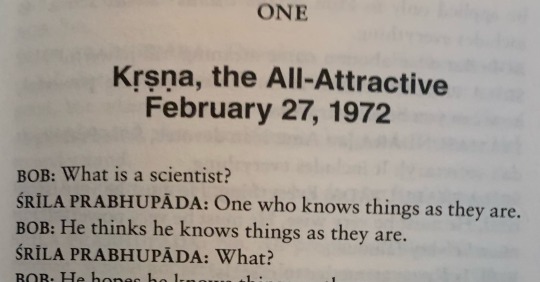
found at the Little Free Library: random Hare Krishna text, I like when Bob tries to riff with Prabhupāda and Prabhupāda is like “what”
#srila prabhupada#hare krishna#krishna consciousness#Bob Cohen#little free library#peace corps#Prabhupāda
4 notes
·
View notes
Text
RELIEF FROM MATERIAL DISTRESS
In Bhagavad-gītā, the Lord says that one should surrender unto Him, giving up all other engagements. The Lord also gives His word there that He will protect surrendered souls from the reactions of all sinful activities. Śrīla Rūpa Gosvāmī says that the distresses from sinful activities are due both to the sins themselves and to sins committed in our past lives. Generally, one commits sinful activities due to ignorance. But ignorance is no excuse for evading the reaction – sinful activities. Sinful activities are of two kinds: those that are mature and those that are not mature. The sinful activities for which we are suffering at the present moment are called mature. The many sinful activities stored within us for which we have not yet suffered are considered immature. For example, a man may have committed criminal acts but not yet been arrested for them. Now, as soon as he is detected, arrest is awaiting him. Similarly, for some of our sinful activities we are awaiting distresses in the future, and for others, which are mature, we are suffering at the present moment.
#bhagavadgita#bhakti#true devotion#hare krishna#hare krsna#krsna#krishna#krishna consciousness#yoga blog#yoga teacher#yogalife#real yoga
4 notes
·
View notes
Photo



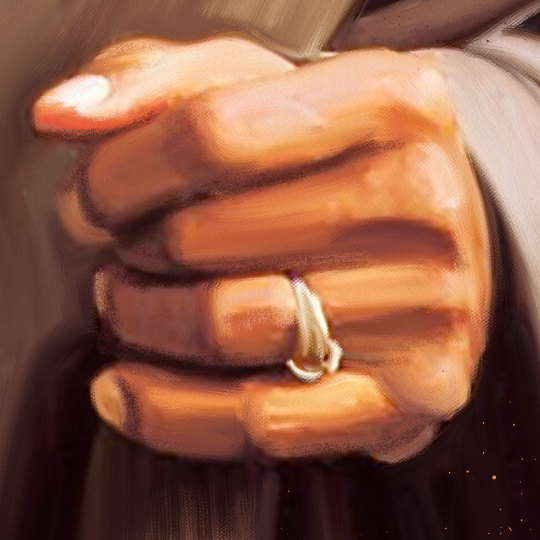
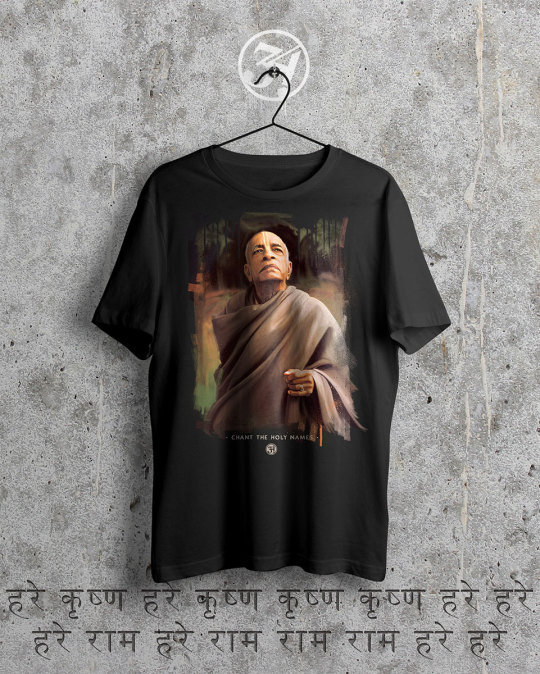
Srila Prabhupada
Messenger of the Bhagavat
It’s been another half eternity since I posted anything here. However, I currently put other priorities in my modest life than to maintain a virtual blog. Be it growing vegetables on our property, my powerlifting training or my path of Sanatana Dharma & Bhakti Yoga.
Nevertheless, there are still a few exciting projects in the works, which I will post here when the time comes and I find the time.
Today, however, I’d like to show another private work here that I’ve been working on off and on over the past few months. It’s certainly not perfect, but it’s still very close to my heart. It is based on one of my favorite photos of Srila Prabhupada aka A.C. Bhaktivedanta Swami Prabhupada, which has accompanied me for half an eternity.
Even though my spiritual path has evolved multifaceted over the past decades, Srila Prabhupada and his teachings undoubtedly have a place in my heart to this day and will accompany me to the end of this material life.
Accordingly, this work is also dedicated to him.
“nama om vishnu-padaya krishna-preshthaya bhu-tale
srimate bhaktivedanta-svamin iti naminenamas te sarasvate deve gaura-vani-pracharine nirvishesha-shunyavadi-pashchatya-desha-tarine”
Take care and be blessed!
#jase34#srilaprabhupada#vedas#Bhagavad Gita#mixed media#digital art#Digital Illustration#painting#Illustration#hinduism#spiritualawakening#hare krishna#krishna consciousness#spiritual revolution#meditation#108#t-shirt#mantra#india#new york#bhakti yoga#swami
4 notes
·
View notes
Text
One who has the desire to know the creator of this universe will never go off from truth and satisfaction

#krishna consciousness#hinduism#spiritual positivity#positive mental attitude#lord krishna#bhagavad gita#karma#motivation
4 notes
·
View notes
Text
Just wondering, no hate, but why doesn't isckon gives preference to mirabai just like Chaitanya mahaprabhu??
1 note
·
View note
Text
The Sanatana Dharma Fandom aka... "Hinduism"

From allowing for the creation of new deities to holding space for contradictory philosophies, what we commonly refer to as Hinduism is probably more accurately described as a spiritual fandom.
What makes Hinduism resemble a fandom is that there is both a canonical authority that sets forth a worldview and there are the modifications and additions to that worldview created by local environments, teachers, lineages, and families. I will explain later how a great number of changes can be made without ever disturbing the underlying premise of Hindu philosophy.
Like most spiritual/religious traditions, Hinduism concerns itself with how to live well and in harmony with the nature of creation. It also has a bonus typically only seen in eastern traditions: enlightenment.
Let's begin with a very general examination of the traditional Hindu approach to human life.
Dharma, Artha, Kama, and Moksha
There are four themes of human life within the fandom: Dharma, Artha, Kama, and Moksha. These themes support a way of life as well as stages of life.
Dharma has many translations and meanings but I would summarize it as being "a sense of honor with respect to your place in this world." Self-discovery and growth are implicit in one's dharma.
Artha is the pursuit of wealth and prosperity for the purpose of livelihood. It entails the activities and resources that allow for harmonious existence within this physical world. It is because of artha that we as humans can survive while also having time and space for higher pursuits, such as art and spirituality.
Kama is pleasure. Rings a bell, right? Oooh yeah the Kama Sutra. I like the Wikipedia definition of Kama: "the aesthetic enjoyment of life, affection, or love, with or without sexual connotations." Everyone, knowingly or unknowingly, is seeking to enjoy themselves and their lives. Kama recognizes and acknowledges this, allowing pleasure a place within the human way of life.
And lastly there is moksha. Perhaps one of the most defining features of all, moksha means liberation. Put simply, all of creation is divinity and all beings are divine. However, for the vast majority of us, this is not a lived experience. Moksha essentially means the realization and embodiment of divinity, as divinity. In other words, enlightenment.
If you put it all together then you get a healthy, well-balanced human life.
As children, we should enjoy life through play, art, and friendship. That is kama and it helps to emphasize why human life is worth supporting and sustaining. And it is important to maintain touch with kama and the playfulness of humanness throughout our lives. Some of us will begin to discover our place, our dharma, in childhood.
Next comes artha, learning how to actually contribute to that support and sustenance of human life. Higher education, getting a job, whatever. Again, one's dharma comes into play as the path through which we seek to do so. Artha acknowledges the reality of living in a society, that survival is not something taken for granted but rather earned. It is not about greed or building vast sums of wealth as its own ends.
And lastly, at any point in life, some people may feel an urge to understand what all of this actually is, what essence resides in/as reality. Revelation of reality is moksha.
While Hinduism is a sea of varying cosmologies, philosophical systems, spiritual lineages, and deities, these four themes are commonly found either explicitly or implicitly within the average citizen's lifestyle.
The Sanatana Dharma
The term "Hinduism" is actually an exonym, a non-native label placed upon it. Now having explained a little about Hinduism, its endonym--the native label for itself--may make a bit more sense: Sanatana Dharma.
You could basically translate it similarly to the Mandalorian phrase "this is the way."
Sanatana means 'eternal' and dharma means 'truth' or 'way.' Dharma is a term that has meaning deeper than in the context of those four themes described above. Dharma is truth and cosmic law. Quantum physics is dharma, sure, but in spiritual circles you will also hear dharma used to describe the truths and practices that reveal moksha, enlightenment.
Another excellent Wikipedia definition for Sanatana Dharma: "the natural and eternal way to live."
In other words, just as everyone knowingly or unknowingly is seeking enjoyment as kama, so too is everyone knowingly or unknowingly seeking to realize the reality of their inner divinity. Because that is the ultimate and lasting enjoyment beyond all enjoyments.
Sanatana Dharma is the way that supports all of this. It supports the possibility for anyone to become enlightened while also supporting those who just want to live well, love fully, and experience a satisfying human life.
While it may be tempting to label Hinduism a colonizing term, the reason why I don't shy away from using it is because the people of the Sanatana Dharma have accepted the term themselves. It is actually kinda handy given that I essentially had to write an essay in order to properly convey Sanatana Dharma's meaning. Someone can just say "Hinduism" instead and you'll know they mean the religion(s) of India.
I know what you're thinking (I don't actually but let's pretend). What about all those gods and rituals and yogis? Where do those come into play when all I've described are some spirit-o-sophical concepts? Here's where I bring us back to the concept of a fandom.
The Hindu Fandom
Firstly, there is the canon aka the source material. There are the vedas, puranas, and various gitas that build out the cosmology and classical plot points. Even within the canon there is differentiation and contradiction yet somehow without discord. Regardless, the general View is that there is a supreme reality that is beyond notions of separation and unity. The term "Brahman" has been given to that supreme reality. I also like that sometimes it is simply called "That."
Various canon stories exist as to how things went from Brahman to Tiktok dance challenges. The main point of all those stories is that manifest physical (and non-physical) realities are all made from Brahman. In all of those stories, there exist super-Beings who played a role in Creation to varying degrees. Those are the Deva, the Shining Ones. They are the gods and goddesses. They had births, they have incredibly long lifespans, and they have deaths. Most of them are also enlightened and were the first gurus to humans.
This leads to the fanon--the ideas of the fanbase that modify the canon--of different lineages within Hinduism. There are those who regard Lord Shiva as the embodiment of the supreme reality, those who regard Vishnu or Krishna as such, and so on. It can get very detailed and nuanced from here. The really, really cool thing is that the fanon is ongoing.
Did you know that a 1975 Bollywood movie popularized an invented deity to the point that she was inducted as a new goddess within the Hindu pantheon? Santoshi Ma, the Goddess of Satisfaction was born from the popularity of the film.
Another example of a new deity being created within Hinduism is something that Sadhguru did in rather spectacular fashion. He put together a whole temple and through ritual installed within it a new goddess named Linga Bhairavi.
Because of the underlying canon, the acceptance of an all-pervading Supreme Reality that is both the source and substance of all things, it is no problem to accept new fanon. Any apparent contradiction is merely superficial.
Why is this okay? It is understood that the Supreme Reality is really beyond anything the human mind can imagine; it is indescribable by any one form or notion of formlessness. The reason why there are so many gods and goddesses is that they each highlight a certain aspect of that Supreme Reality and anthropomorphize it such that we can begin to relate with and understand something so limitless.
Depending on our dharma, karma, and so on, our temperaments will lead us to the divine in different styles. Krishna has a different vibe than Lord Shiva, after all. I guess we could say that's kind of a form of shipping? Lol. And if there isn't a particularly relatable form of the divine available, a new one can be born.
Lastly, continuing with our fandom theme, is headcanon. These are your own notions and understanding of the canon material. If you choose to become an active practitioner in your own spiritual path, your insights and experiences may give rise to fresh expressions of this eternal truth, of the Sanatana Dharma.
Sometimes a great guru's headcanon modifies the fanon, which in turn leads to a change in the canon. It's pretty damn cool that there is room for such a thing yet there is no official committee or rules about any of it.
Anyway, none of this really even gets into much detail about Hinduism in general or any particular philosophical schools or spiritual lineages within it. But I hope it does manage to convey the de-centralized premise and living nature of the Sanatana Dharma.
LY
#hinduism#sanatana dharma#yoga#spirituality#meditation#buddhism#consciousness#philosophy#fandom#headcanon#fanon#shiva#krishna#vishnu#ganesha#tantra#kali
75 notes
·
View notes
Text

O flute,
You have no tongue,
yet you wail all day?
For whom do you cry?
The flute replied:
They took me from His sweet lips.
What else can I do but cry?
~ Rumi
58 notes
·
View notes
Video
youtube
Mayapur Kirtan Mela Singer G.H Premanjali Debi Dasi

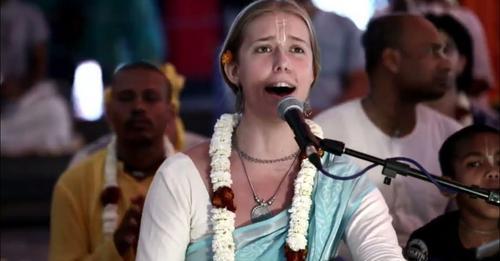
Mayapur Kirtan Mela ~Singer G.H Premanjali Debi Dasi https://youtu.be/PaGr5BQ2-Ko?si=aULEOfRxUXcZR0eF via @YouTube
#youtube#Kirtan#ISKCON#Mayapur#ISKCON Mayapur#Hare Krishna#Krishna#Bhakti#Vedic#Vishnu#Krishna consciousness#Bhajan
7 notes
·
View notes
Text
How old were you when you realised that Vishnu's Dashavataras represent the evolution of mankind
#matsya = fish#kurma = sea dwellers#varaha = the first vertebrates#narsimha = half man half animal#parshurama = man with axe/weapon#vamana = man developing higher intellect#rama = the perfect man#krishna = man developing consciousness about dharma and adharma#buddha = man ascending to enlightenment#kalki = the end of adharmi mankind#i havent slept in 4 days#hinduism#hindu memes#hindu epics#hindu mythology memes#hindu mythology#hindublr#hindusim#vaishnavism#vishnu
3 notes
·
View notes